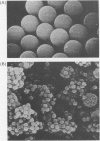Abstract
Improvements to the original procedure of using a panel of monoclonal antibodies and magnetic microspheres for the depletion of tumour cells from bone marrow are described. These include a completely disposable system for the magnetic depletion of tumour cells coated with magnetic microspheres. Properties of a new series of microspheres are compared with the old M330 beads in their ability to deplete neuroblasts from both model systems and 50 bone marrows harvested from Stage IV neuroblastoma patients. Using human neuroblastoma cell lines labelled with the DNA intercalating, Hoechst dye 33342 a 5% tumour contamination can routinely be removed from 5 X 10(6) - 5 X 10(7) nucleated cells. Analysis of the 50 purged marrows revealed that 10 were visibly contaminated with tumour (by conventional cytology and immunological procedures). In all but one case, tumour cells were removed. In this instance the tumour:bead ratio fell to 1:4 indicating the importance of maintaining a sufficient number of beads in the system. Red cell contamination of marrow was also kept extremely low so preventing possible physical blockade of bead:tumour cell interaction. Marrow engraftment was rapid in this group, apart from patients who had been exposed to high doses of alkylating agents prior to autografting.
Full text
PDF







Images in this article
Selected References
These references are in PubMed. This may not be the complete list of references from this article.
- Buck J., Bruchelt G., Girgert R., Treuner J., Niethammer D. Specific uptake of m-[125I]iodobenzylguanidine in the human neuroblastoma cell line SK-N-SH. Cancer Res. 1985 Dec;45(12 Pt 1):6366–6370. [PubMed] [Google Scholar]
- Eisenbarth G. S., Walsh F. S., Nirenberg M. Monoclonal antibody to a plasma membrane antigen of neurons. Proc Natl Acad Sci U S A. 1979 Oct;76(10):4913–4917. doi: 10.1073/pnas.76.10.4913. [DOI] [PMC free article] [PubMed] [Google Scholar]
- Evans A. E., D'Angio G. J., Randolph J. A proposed staging for children with neuroblastoma. Children's cancer study group A. Cancer. 1971 Feb;27(2):374–378. doi: 10.1002/1097-0142(197102)27:2<374::aid-cncr2820270221>3.0.co;2-g. [DOI] [PubMed] [Google Scholar]
- Fauser A. A., Messner H. A. Identification of megakaryocytes, macrophages, and eosinophils in colonies of human bone marrow containing neurtophilic granulocytes and erythroblasts. Blood. 1979 May;53(5):1023–1027. [PubMed] [Google Scholar]
- Figdor C. G., Voute P. A., de Kraker J., Vernie L. N., Bont W. S. Physical cell separation of neuroblastoma cells from bone marrow. Prog Clin Biol Res. 1985;175:459–470. [PubMed] [Google Scholar]
- Kemshead J. T., Treleaven J. G., Gibson F. M., Ugelstad J., Rembaum A., Philip T. Monoclonal antibodies and magnetic microspheres used for the depletion of malignant cells from bone marrow. Prog Clin Biol Res. 1985;175:413–423. [PubMed] [Google Scholar]
- Kennett R. H., Gilbert F. Hybrid myelomas producing antibodies against a human neuroblastoma antigen present on fetal brain. Science. 1979 Mar 16;203(4385):1120–1121. doi: 10.1126/science.424740. [DOI] [PubMed] [Google Scholar]
- Reisner Y. Differential agglutination by soybean agglutinin of human leukemia and neuroblastoma cell lines: potential application to autologous bone marrow transplantation. Proc Natl Acad Sci U S A. 1983 Nov;80(21):6657–6661. doi: 10.1073/pnas.80.21.6657. [DOI] [PMC free article] [PubMed] [Google Scholar]
- Reynolds C. P., Reynolds D. A., Frenkel E. P., Smith R. G. Selective toxicity of 6-hydroxydopamine and ascorbate for human neuroblastoma in vitro: a model for clearing marrow prior to autologous transplant. Cancer Res. 1982 Apr;42(4):1331–1336. [PubMed] [Google Scholar]
- Saarinen U. M., Coccia P. F., Gerson S. L., Pelley R., Cheung N. K. Eradication of neuroblastoma cells in vitro by monoclonal antibody and human complement: method for purging autologous bone marrow. Cancer Res. 1985 Nov;45(11 Pt 2):5969–5975. [PubMed] [Google Scholar]
- Treleaven J. G., Kemshead J. T. Removal of tumour cells from bone marrow: an evaluation of the available techniques. Hematol Oncol. 1985 Jan-Mar;3(1):65–75. doi: 10.1002/hon.2900030109. [DOI] [PubMed] [Google Scholar]



